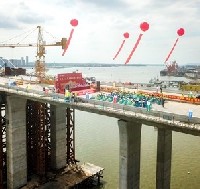Pedestrians and cyclists could once again cross the Rhine at the site of the destroyed steel arch bridge, according to authors of a feasibility study conducted earlier this month into the construction of a new crossing. Officials from the city of Remagen in west Germany have stated that a 325m-long, 6m-wide structure between the historic bridge’s twin masonry towers on both banks of the Rhine is both “feasible and realistic”.
 Stadt Remagen
Stadt Remagen
Analysis of different typological options favoured the basic solution of a suspension bridge with individual pylons positioned behind the still-standing side span towers. The new structure would lie on the same axis as the old and rest on the original abutments.
The engineering office commissioned to conduct the study has estimated net construction costs of US$22 million, taking into account the aforementioned dimensions, as well as the renovation of existing historic structures, and construction of new stairs, ramps and elevators.
The plan has also received significant public backing: an online survey carried out in cooperation with the Koblenz University of Applied Sciences found that over 90% of respondents were in favour of the bridge, expecting it would have a positive effect on the surrounding municipalities, tourism, the economy and job market, the attractiveness of the area as a place to live, and on the permanent preservation of the historic bridgeheads.
Ludendorff Bridge, also known as the Remagen Bridge, was built during the First World War at the insistence of the German generals in order to bring more troops and resources to the Western Front. The railway crossing was designed by the architect Karl Wiener, had a length 325m and a vertical clearance of 14.8m from the water, with the crown of the arch standing at 29.25m. It carried two railway tracks and a footway and was considered one of the most beautiful steel bridges over the Rhine.
Towards the end of the Second World War, on 7 March 1945, a small part of the 9th US Armoured Division under Lieutenant Karl H Timmermann, succeeded in capturing the bridge, with the event coming to be known as the Miracle of Remagen. On the same day, German Major Hans Scheller ordered the bridge be blown up. However, too small a quantity of explosives meant that the resulting blast only momentarily lifted the bridge from its bearings.
Video showing the events around the capture and subsequent collapse of the original steel arch bridge
In the days that followed, German soldiers attempted to retake the bridge but were unsuccessful, as were further attempts to destroy the bridge with bomb attacks. Nonetheless, ten days after its capture, the damaged and most likely overloaded bridge suddenly collapsed, killing a number of American soldiers.
The events are captured in the Hollywood film, The Bridge at Remagen, and today there is a peace museum in each of the towers on the western bank of the Rhine.



